|
|
Post by dimasalang on Nov 21, 2008 17:48:49 GMT -5
|
|
|
|
Post by VeeVee on Nov 21, 2008 22:22:00 GMT -5
Nice picture Kev. What rifle is that?
|
|
|
|
Post by jimmay on Nov 22, 2008 12:22:38 GMT -5
those rifles appear to be spanish M1893 Mausers VeeVee. I find those hatsthe riflemen to be interesting though, kinda based on European, I think Russian, style
|
|
|
|
Post by legionnaire on Nov 25, 2008 3:17:58 GMT -5
Those are members of the Early Philippine Constabulary. They are wearing grey tunics called "Camano" Uniforms with white trousers. And since they are using "captured" Spanish Mausers issued to militia/ civil police force like the early Constabulary units.
Philippine Scouts would have US Army issued Krag rifles and wore US Stetson hats and blue wool or khaki tunic and OD or khaki trouser uniform with canvass leggings at that period. The same issued to the US Infantryman after the Span-Am war.
Philip
|
|
|
|
Post by dimasalang on Nov 26, 2008 15:59:32 GMT -5
Correct these are not scouts. They are PC's. The photo was mislabled "Native Scouts". I just found the photo and didn't bother analyzing it but wanted to post it here shorty after I seen it. Anyways, if I remember right the Scouts were first issued the left over 45 caliber "single shot" Springfield rifles(used by some units of the Volunteers). Years later they were issued Krags. Any photos with them of the single shot rifles would be the earlier scouts. Title edited and corrected.  |
|
|
|
Post by dimasalang on Nov 26, 2008 17:11:18 GMT -5
Another photo labled "Inspection of newly created police force. Manila - 1899".  |
|
|
|
Post by RayAdillO on Nov 26, 2008 17:21:32 GMT -5
It's rather funny that the civil American authorities would issue the constabulary a far superior weapon like the Mauser instead of the Krag....a snipe at the Army perhaps?
But I guess this was but a reflection of the growing rivalry between the U.S. Army and the civilian governor-generalship (as to which department really had final authority over the islands), reflected in the rather cold relationship between Arthur MacArthur and Willam Howard Taft.
This intense inter-departmental and inter-service rivalry was carried on between the Philippine Scouts (under the Philippine Department of the U.S. Army) and the Philippine Constabulary (under the U.S. governor-general and later, the commonwealth government).
|
|
|
|
Post by RayAdillO on May 2, 2009 7:09:57 GMT -5
A few more phots and illustrations of concerning the early Philippine Constabulary 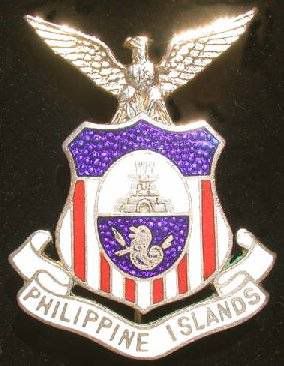  Early PC Insignias  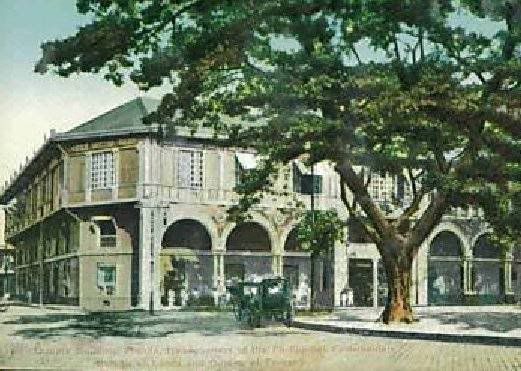 PC Headquarters at the Oriente Bldg., Manila 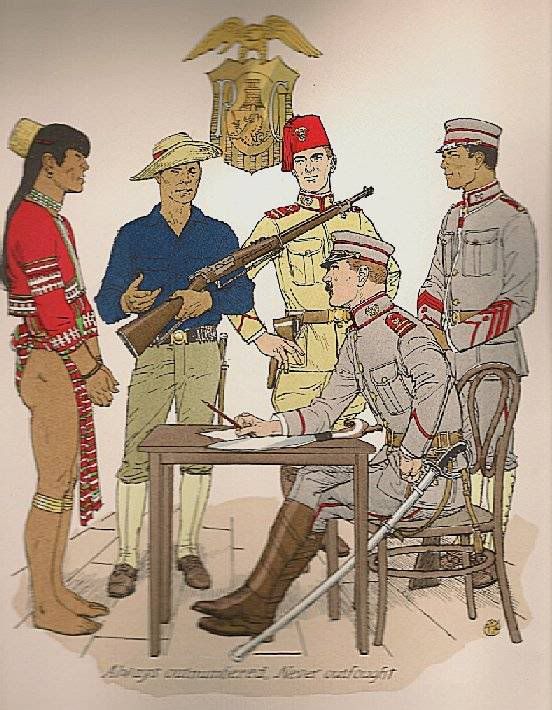 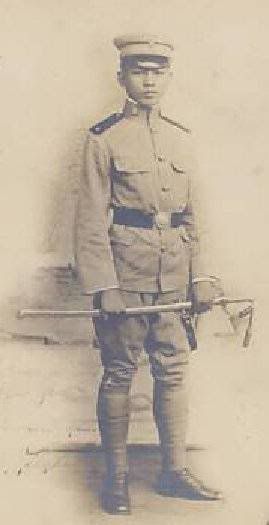 Gray "Camano" cloth uniforms which the Constabulary wore up till around 1906.  A mandatory early 20th century photgraphic explanation as to the "civilizing" effects of philippine natives joining the constbulary. 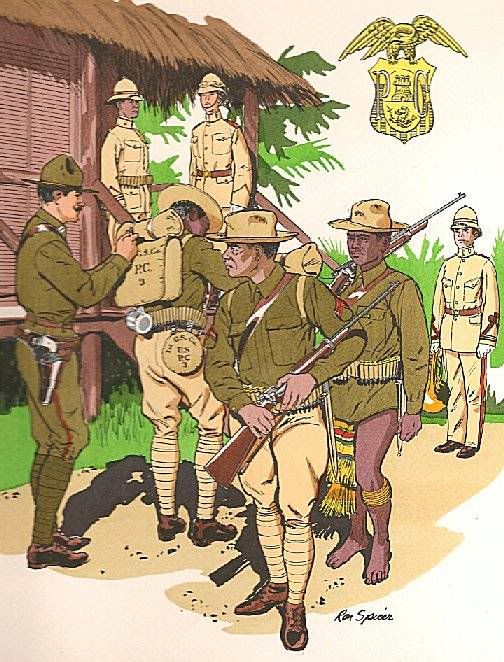 PC drab and khaki uniforms at around 1910 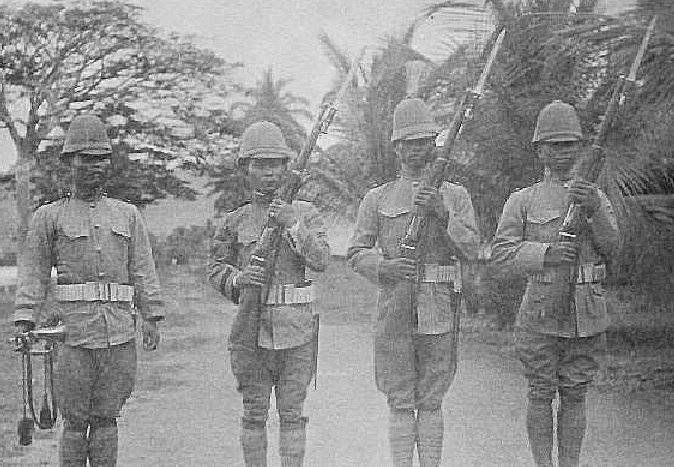 Note khaki uniforms and sunhelmets 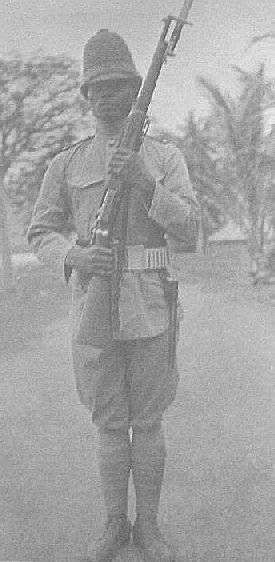 |
|
|
|
Post by VeeVee on May 2, 2009 8:02:08 GMT -5
Very nice Ray. Thanks for these info. I love these rare photos. I'm going to host the pictures in my photobucket so they don't expire.
|
|
|
|
Post by RayAdillO on May 2, 2009 19:49:41 GMT -5
Many Thanks VeeVee.
|
|
|
|
Post by legionnaire on Jun 4, 2009 6:30:23 GMT -5
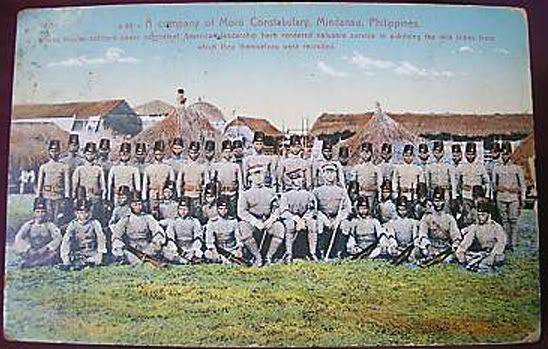 A Company of Moro Constabulary Mindanao, P.I. You can have an idea of the gray Camano Uniforms and black Fez from this colorized postcard. The enlistedmen standing could be in khaki colors. |
|
|
|
Post by ibarramedia on Jun 9, 2009 17:56:10 GMT -5
So is it safe to assume that the newly created police force was comprised of disbanded former guardia civil troops?
|
|
|
|
Post by RayAdillO on Jul 17, 2011 6:05:02 GMT -5
Yes, more than likely ex-civil guardsmen would have been recruited into the constabulary in view of their police/anti-insurgent operational experience, but then former members of the Filipino independence army were also recruited after the formal surrender of many such formations from the time of Aguinaldo's capture through the early 1900s. I would regard this a no loss of honor really, they knew the gamble was up and so they just wanted to restore a sense of law and order in the countryside against local banditry.
|
|
|
|
Post by RayAdillO on Jul 17, 2011 6:16:33 GMT -5
A picture of a major or lieut. colonel of the Philippine Constabulary, perhaps from 1914 up to the 1920s.  Of interest are the hat and collar insignia, and the early Philippine "Medal of Valor" with a "PC" monogram over the small shield below the ribbon. (red ribbon with white stars).  |
|
|
|
Post by legionnaire on Jul 18, 2011 11:14:15 GMT -5
Here's a brief history of Lt. Col. Paulino Santos when he received his medal of valor in 1935
for actions done in 1917 when he was a lieutenant.
He enlisted in the Philippine Constabulary. He was assigned to its First General Service Company.
In 1912, he was promoted from private to supply sergeant, serving as such for two years.
Simultaneously, he strove to upgrade his skills and knowledge by pursuing his studies.
His perseverance paid off, for he soon finished high school.
In 1913, he passed the entrance examinations to the Philippine Military Academy in
Baguio, then known as the Constabulary Officers School.
In 1914, he graduated, not surprisingly,as class valedictorian, and was commissioned third lieutenant
in the regular force in February of the same year. Thereafter, his rise through the ranks was swift:
second lieutenant in 1917, captain in 1918, major in 1923. He was adjutant of the Headquarters,
of the Philippine Constabulary before retiring as lieutenant colonel in 1930.
As soldier, Santos served in the Lanao campaign in 1916, where he sustained wounds from
a Moro spear, and in the Bayang Cota campaign in 1917, where he was wounded anew, but this
time by bullets. It was in the latter campaign that he demonstrated extraordinary courage and
leadership.
on 26 July 1917, as government cannons were bombarding the Muslim bulwark of Lumamba,
on the lake shores of Lanao. Then 2nd Lieutenant Santos led his platoon from three companies of Philippine Scouts
in penetrating the formerly secure redoubt, through an opening made in the barricade, and immediately erected a ladder
to scale the first kota. Immediately, he and his men engaged its defenders in a bloody hand-to-hand combat,
killing 30 of them, and thus preserving the lives of government soldiers. With only one casualty and four wounded.
For this exceptional military feat, Governor General Frank Murphy bestowed on him, the medal of valor,
the highest military award, for “gallantry in action”, just before the inauguration of the Commonwealth government in 1935.
He was named President Quezon’s aide for the inaugural ceremony. Before the year’s end,
however, he was named Chief of Staff of the Philippine Army with the rank of Major General.
|
|
|
|
Post by snowpy on Aug 7, 2011 11:18:05 GMT -5
dear sirs,
the picture presented is neither gen. paulino santos nor gen. rafael crame (as manolo quezon III mentioned in his website). Gen. paulino Santos got his MOV in Nov. 1935. As you can see the person in the picture is wearing a 1915-1920's Phil. Constabulary uniform with a very early(earliest) Type I MOV. In 1935 the MOV (Type II Pls. see "Philippine Medals" by Robert Reynolds) design was a cross pattee.Ergo he is not Gen. Santos. And if you look at the picture very closely, he does not even resemble gen. paulino Santos! Is he Gen. Rafael Crame? He does look like Crame, including the Antonio Luna mustache...but he is not! Why? Rafael Crame got his MOV in 1920 when he was already a general!And by the way, he refused to accept the MOV awarded to him! Look at the rank in the picture- he is either a major or Lt. Col.
If he is not Paulino Santos or Rafael Crame then who is he? If you have Maj. Emanuel Baja's 1933 book entitled "The Medal of Valor", the onlyFilipino officer (major or higher) who earned the medal of valor who can fit the the timeline when the picture was made ( about 1920's) is Major Antonio Costosa. This is a very, very rare picture of a MOV awardee wearing the first type MOV. I have been a medal collector for 7 years . I have been gathering data about the history of Philippine medals since then. I almost cried when I saw this picture because I recognized the Type I MOV. There is no existing picture or actual medal available (until this picture). Robert reynolds only described the typeI MOV but no pictures were ever printed because it was thought that no picture existed until now. i hope that you can support me when i finally write my opus on the history of Philippine medals.
N.B. there are 5 types of MOV (Philippines). hope you read my article on the MOV someday.
Costosa got the MOV when he was a captain in1920. Promoted to major in the same year but remained in this rank for about 2 years. he died in 1922. the picture was taken between 1920 and 1922
|
|
|
|
Post by frank on Aug 7, 2011 19:38:50 GMT -5
Thank you.
Hope to hear from you again soon.
|
|
|
|
Post by leoniii on Aug 20, 2011 6:32:09 GMT -5
The Mauser model 93s were issued to the Constabulary in the early part of the American Occupation, because they were captured rifles originally from the Spanish arsenals. These rifles may have actually changed hands from Spanish to Filipino rebel to American then back to Filipino constabulary. While the Mausers were of a superior rifle design compared to the Krags, they were not standard US Army issue, and the 7mm ammunition for these rifles would have also been captured Spanish stock. Until the Americans were able to standardize and import uniforms, weapons and equiptment for colonial Filipino units they created, captured weapons were the practical way to go. These weapons were already available in-country. No different from arming Iraqi or Afghan aramed forces and police with captured AKs instead of M4s today. The Americans did however, appreciate the superiority of the Mauser design and this led to the adoption of the M1903 Springfields as standard issue. As for the Russian looking headgear on the PC troopers,....these were Spanish pattern peaked caps also from captured inventory. Gregorio del Pilar wore a similar cap in his famous horse mounted photo.
|
|
|
|
Post by Mercy Jane on Dec 4, 2015 13:09:43 GMT -5
Hi sir, I'm working on my thesis now on Philippine Constabulary in Labason, Zamboanga del Norte. Would you be so kind to give me more informations about them, like their encounters with the MNLF. It would really be a great help for my study.
|
|
|
|
Post by Alex Ford on Sept 5, 2019 2:18:51 GMT -5
I'm fascinated by an organization that was developed under an outline by Luke Wright, a member of the Philippine Commission. I personally don't think all the histories I've found coming out of the Philippines, most of which are copies of each other or one another (those histories). As originally named, the Philippine Constabulary was a unique name. The Americans had a lot of reasons to develop the Constabulary as students of Constabulary like you men well know. Of course the underlying reason was money. The base reason under that is something I have read time and again from Filipino historians; American historians; Japaneses historians regarding the Philippines; even British and Chinese historians. I haven't seen Russian or Australian fans of the Philippines write very much if anything, although they may well be out there. I believe that it was ill-advised for American authorities to not include the available officers and/or civil authorities with the Americans during the briefest, "War," on record. As pointed out by a slew of writers such as Mark Twain, a Democracy had no business going to war with Spain to attempt to take over a group of "territories," and thus get in on the idea of Imperialism as promulgated by the United Kingdom, likely the Kings of Imperial acquisition from the 1700's through the end of World War II. Even in the modern era of the "New World Order," (is there really such a thing?), the U.K. went to war with that bastion of ranked world powers: "The Falkland Islands." (If we were studying medals of the UK, that skirmish with the Falklands would probably have more than one and maybe even two or three versions, right?
Anyway, it is my contention that a majority of Americans realized what had happened after a war that the news media created (the Hearst newspapers?) and also had an epiphany within months of the Treaty of Paris. Popular opinion also exerted pressures that resulted in a sort of, "We were here first," situation by the Military Governors (over which there were four, I believe) who wanted to set policy just like conquering armies of the past did. Meanwhile back in the States a number of Senators and Congress during the first four years of U. S., "ownership," (Treaty of Paris; paying off Spain; and paying off the Catholic church seems like someone in the U.S. government thought they paid the necessary fees for their new acquisitions. I mean, how are those things refutable when once includes the language of the Treaty. While the expense of occupying the Philippines horrified about 20-30 percent of general Americans (the rest did not really understand the Spanish-American War and what it was or what it was for, and therefore are not really included. Ignorance there meant general apathy. The "Preparedness" group of Americans were heavily in favor of taking over the Philippines for strategic purposes first with the attendant military considerations for the United States, world wide. The two other groups with strong opinions were the businesses and farmers who competed directly with Philippine products. Those who wanted to move in to the P.I. and take advantage of the tremendous natural resources were for both acquisition and then maintenance of ownership. The others wanted no part of the competition from the Philippines, visualizing that their profits would be severely undercut. Then there were two more sets of opinions at work by the small group of Americans who understood the direction of the world in terms of, "nationalism." Peoples all over the earth continued to fight against being conquered and taken and there was a general demand for independence. The Philippines were just a prime example. Other nations would follow in the next 47 years with certain pressure from the United Nations as well as groups of "Treaty Nations." (Just too many to list.) Whether the majority of Americans knew it or not, no later than 2003, but as early as 1899, the lawmakers knew that they were going to have to back-pedal and claim that the United States was just a, "big brother," taking care of his little one, until they could get their own fully functioning government system; police force; army, navy and air force; stabilized economy and a fully functioning educations system.
Regardless of all that, a creation of a police force administered by civil authorities instead of military authorities. Forget all of these rivalries whether they happened to the degree we think they did (they did). The overview is that the Scouts were really military and were thus not going to be available to be a civil State Police Force. (Actually, the Scouts might well have said, "OK. You be the policement. We will become the leaders and the soldiers of the Army of the Republic when that happens." We know that once the Army started development with plans being considered before the advent of the Commonwealth and then after that historic change, an acknowledgement by the United States that autonomy was gong to be granted and that it was going to be developing the whole ten years. Most Americans could leave and go home. Filipinos with knowledge of such things knew that since Governor-General Harrison was appointed that America was de facto leaving the Philippines to Filipinos to develop their nation themselves.
I've said too much about all of this. Books have been written, many of them or Journal series have been written about what the Japanese Empire meaning its military and its intellectuals thought about the Philippines: not only was it ripe for the picking, but Japan very badly wanted to acquire the Philippines and keep them permanently under Japanese rule for all the economic advantages Japan would gain. (Same old Imperial story like islands of the world's waters and lands of India, the middle east, and Africa).
Those same Americans who did not want to spend money in or on the Philippines, also did not want to spend money providing the Philippines with weapons and equipment, planes and ships. Those Americans just want to get out "NOW," and leave the Islanders to their own purposes. After all hadn't the Filipinos risen up against the Spanish in 1896? Spain not able to afford the Philippines any more as well as having an antiquated navy that couldn't stop a group of natives with canoes, would likely have gone down to defeat by the Rebellion, if the U.S. had simply been a partner with the Filipinos and just backed them up. 330 years of Spanish rule was enough. (Japan would have become a problem, not-with-standing.
Thus, since the U.S. of A. came in for a moment in time thinking that it was going to have a new territory, the United States then quickly revised its intentions with the statement of one of the Military governors and then received a follow up promise from William H. Taft, while he was G-G if I remember correctly.
To do any of that, or all of that, the only way was to develop a National police, a gendarmerie; a constabulary. Not just any constabulary. The Philippine Constabulary. The Americans wanted it; if they were to stay and the did, they needed it. A few main players in the U. S. Government discussed the need for the need for it and how it would look. Doesn't matter really who got credit for it. Luke Wright or whoever. Amazingly, from the time the idea and its vague outline was first thought of, the Americans put together the concept aptly enough that it could be put in writing and argued before the Congress of the United States and the bill passed and signed by a President who knew when he did so that he would have appointment power over the "Insurlar Government," in the Philippine Islands. Concessions would forever follow both civilly and militarily, but the Philippine Constabulary was developed by Americans for mutual benefit of both Filipinos and Americans. And the Constabulary, with its manual was distinctly Filipino. I don't question that. It was of course run by mostly American Army Officers and a few American enlisted personnel who became officers. And there were other non--Filipino officers as well, including an Englishman who became a Constabulary officer; there was a Sweed. There was another, a different kind of Brit. There were a couple of Germans. But without all of those troops that were Filipino, there would not have been a Constabulary. As pointed out in words and pictures, there were also Filipino Officers from very early on.
It could be argued that Rafael Crame was not a Filipino, but he was. He like a lot of Filipinos, including Presidents of the Republic had mixed blook. If Rafael Crame was one of the most efficient Chiefs of Constabulary, one of my favorites was Basilio Valdez. I look at when he came in. I look at how professional he was. And I look at a lot of photos I've seen and there is Basilio Valdez in uniform, fully aware of where he was and what he was doing and what was at stake at all times. He could have complained about any number of things, any number of times. But he took what the Americans had started. He stood by while they played their promotional games. And out of it all, it is he and not somebody else who was the last Insular Period, Chief of the Philippine Constabulary. I'm sure there are people that will use definitions of terms to dispute this, but that is my opinion. After all the official date of the beginning of the Commonwealth of the Philippines is November 15, 1935 and it would have become a full-fledged Republic if it were not for a Japanese attack and take-over, which consisted of little more than an ongoing violation of International law as it relates to war crimes.
Last thing I'd like to point out if I may. Until the Philippine Constabulary, the best example of a people's national police force had been the one established in India. It was a major example of efficiency and was created into a very professional state police force. However, the new title of the best ever surfaced very shortly after the birth of the Constabulary and the reputation of the force for the most part as the best National Police Force in the World rested with the Philippine Constabulary. As a result of that and the persons involved in it from all nations who took the Constabulary oath of office, no force exceeded the Constabulary in bravery, efficiency and overall respect from the outside than the Philippine Constabulary. The only thing that stopped it and the only thing that toppled it was the Republic eventually doing away with it.
What does this mean for us today? It means we have the opportunity to study the P.C. with all of its surviving records; with all of its photographs and drawings and with all of its artifacts and all of its relics, kept by different people from all over the world. It is only with the kind of people who I saw write into this Forum who can preserve its history and talk to one another and find out what really happened and who really did what.
I mean a discussion could be had even as to the most famous of all the Philippine Deserters and we might be reminded of what happened to them. Those were very rare, because right down to the medical corps and the band, the P.C. as a whole was an incredibly valorous group of men. AF
|
|